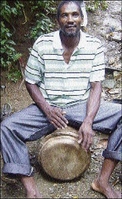Kumina still kicking in St Thomas
Published: Sunday | October 11, 2009

A member of the Seaforth Kumina Group using the traditional household grater to make beautiful music. - Ricardo Makyn/Staff Photoghrapher
When West African slaves arrived in the Caribbean, centuries ago, they came bereft of their pride, dignity and earthly possessions. In many ways they were suppressed, and their spirits were broken, but not for long. For, in their heads, hips, hands and feet, they had things that no whip and shackle could forever vanquish. They had music, movements and magical fingers, which they passed on to their descendants, a testament to their resilience.
Centuries after the very first set of slaves landed, there are still retentions of their West African culture in the Caribbean, and right here in Jamaica, they are robust and rich, though not as popular as contemporary forms. In St Thomas, at the eastern end of the island, where there seemed not to be much interbreeding between whites and blacks, remnants of our black ancestors' struggles and liberation are everywhere, oozing life. One element that is particularly vibrant is the electrifying Kumina.
Kumina is a ritualistic medium through which our African ancestors are celebrated and appeased. It's an art form combining dancing, singing and drumming, and has distinctive movements and cadences that make it easily recognisable. But, it is the hypnotic sounds of the Kumina drums, made of tree trunks and goatskin, that epitomise its essence. It is not easy to imitate, and very hard to duplicate.
All over St Thomas there are splinter groups, mainly in Seaforth, Acadia, Trinityville and Port Morant, doing their best to preserve this fascinating aspect of our heritage. One such group which is helping to keep the culture alive is the Seaforth Dust to Dawn Kumina Group. Led by master drummer and singer, Whitmore Simpson, the group has been making quite a name for itself nationally. In existence for a little over 10 years, it has won a number of gold medals in the annual Jamaica Cultural Development Commission performing arts competitions. And there is no wonder why they have.
Simpson and many of his group members have been brought up in households where Kumina was a staple. His mother and father were ardent practitioners, and a sister used to be a 'Kumina Queen', known for dancing with a lit lamp on her head. He is quite a 'Kumina King' himself, proficient at singing, dancing and drumming, and at making and repairing drums.
Having learned most of what he knows from his parents, he has been passing on the legacy. His own young children are exposed to Kumina and they are turning out to be quite interested in it. "We have to preserve all of it because any way you take it, you still will have people who belittle it, you still will have people who accept it ... we have to preserve the culture that we have ... the culture is all that we have left," declared Simpson, who goes around to various schools teaching and performing Kumina.
At 74, Gerald Walker is Seaforth's elderly 'Kumina King', still making drums for sale. He has one of the widest vocabularies of what is left of the Ibo (Igbo) language in St Thomas. He toured with the National Dance Theatre Company (NDTC) for about 25 years, playing the Kumina drums for the NDTC's internationally acclaimed dance piece simply called 'Kumina'. "It's a great experience, a tradition that cyan done ... Kumina never stop, cyaan stop," he said, with great determination.
magnetic power
Mark Mitchell and Everton Miller are not as old as Gerald Walker, but they too are helping to keep Kumina on the front burners. Kumina, to them, is a type of enjoyment that has a magnetic power they can't resist. And so wherever it is and if it is possible for them to be there, they will go. It is the spirit of togetherness, which Kumina exudes, that they find alluring. "Is a culture that needs to be passed on, to carry on forever ... If you should know the joy that it brings, nuff young people would be involved," Mitchell claimed.
But while Kumina still has scores of ardent practitioners, it is regarded by many people, even some in St Thomas, as demon and ancestor worshipping, because of its association with wakes and funerals, and the tendency of the drums to get some participants and bystanders into Myal (a trancelike state), from time to time. It is even perceived as "bad obeah" (witchcraft).
According to Simpson, Kumina can heal, but it can also harm, if not used for the right purposes, especially if used mockingly. Yet, Kumina is also performed at birthdays, anniversaries and special occasions. It is a form of entertainment just like any other. Moreover, he said, good and bad are found in all facets of life. He said what he's doing is not evil and "it belong to us so we have to gladly accept it and keep it".
Such sentiments are shared by Miller who plays the bass drum and the 'shake-shake', also called 'shaka'. "Some people don't understand it, because some a dem say it's evilous. Some a dem fraid of it, but to me, it's a joy ... Kumina need fi keep, forever, and ever, and ever," Miller stated, "Mi say Kumina over Gully and Gaza, a my culture dis." And there is no end to the love affair with Kumina.

In this 1973 file photo, the Seaforth Kumina Drummers play at an event in Denbigh, Clarendon, while a young girl dances to the beat. - File

Whitmore Simpson, current leader of the Seaforth Kumina Group. - Photo by Paul H. Williams
negative perception
"I love Kumina because I do not know the bad side of it," Dayon Barclay proudly said, in response to questions about the negative perception of Kumina by some people. Barclay is a regular 'grater scraper' with the group. Her initiation was very different from Simpson's and other group members'. She once happened on a Kumina group in rehearsal, and was invited to join. Reluctantly, she did, but eventually got hooked. Dancing is not her forte, but she is regarded as one of the better 'scrapers' in the group, claiming never to have missed a beat.
Despite the negative perception of it in some quarters, Kumina is kicking and thumping. A powerful and uniting force it is, bridging many gaps - between the past the present, slavery and freedom, war and peace, the ancestors and their descendants. It's a balm to soothe the soul and to liberate the mind. "The sound of the drum frees up the mind, because you will have people who are down and when they go to the Kumina dance, they forget their troubles," said Simpson, one of the keepers of the heritage of the pulsating Kumina.
paul.williams@gleanerjm.com
















